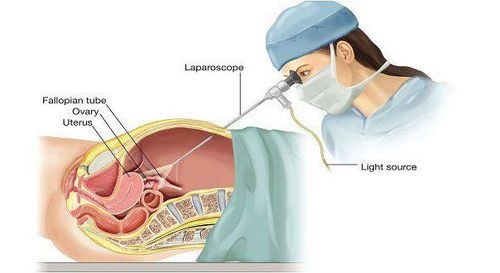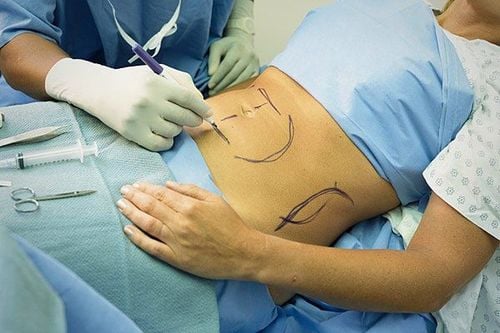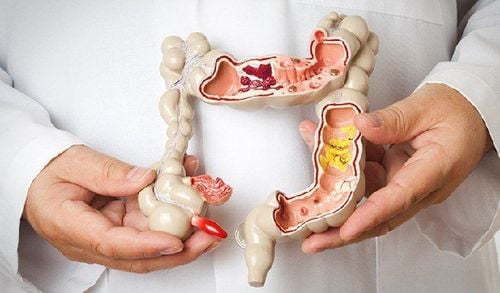This is an automatically translated article.
The article is professionally consulted by Master, Doctor Mai Vien Phuong - Gastroenterologist - Department of Medical Examination & Internal Medicine - Vinmec Central Park International General Hospital.Laparoscopy is performed when it is necessary to view the internal organs of the abdomen. This surgery takes place quickly, with less damage, less pain, and quick recovery time, so it is commonly applied.
1. What is laparoscopy?
Laparoscopy is a minimally invasive surgical imaging method. Laparoscopy can be combined to treat many related diseases. There are pathological cases where it is not possible to determine the exact condition, location of the lesion, the cause of the injury even after taking X-ray, ultrasound, forcing direct observation. At that time, laparoscopy is performed to aid in the diagnosis of visceral problems in the abdomen and pelvis. In particular, laparoscopy is performed a lot in gynecology.The doctor will use a metal tube with a camera attached to which the light is inserted into the patient's body to view the entire abdomen, from which a diagnosis and specific treatment can be given. body.
2. How is the laparoscopic procedure performed?

Before performing laparoscopy, the patient will be under general anesthesia. For minor procedures such as tubal ligation, patients may only need subdural anesthesia. But most of the time, the patient will be under general anesthesia, losing sensation during the surgery.
Laparoscopy procedure includes:
The doctor will make a small incision on the abdominal wall, just below the patient's navel. Small incisions less than 1.5 inches. Then, the doctor introduces carbon dioxide gas inside the patient's abdominal cavity through a needle to bulge the abdomen, making it easier to see the internal organs; The doctor uses a trocar to poke through the previous incision to create a way for the endoscope to enter the patient's body; The endoscope is fitted with a viewing device and a specialized lighting device. The image obtained through the camera will be transmitted to an external monitor. Based on the obtained images, doctors can grasp the condition, extent of damage, location of damage and offer treatment plans; If the lesions can be treated, doctors will combine surgery to solve the disease. At that time, the doctor will make a few more small incisions on the patient's abdomen to put the surgical instruments inside.
3. Is laparoscopy painful?
Before performing laparoscopy, the patient is under general anesthesia, so the patient will sleep during the procedure and feel no pain. After the effect of the anesthetic wears off, the patient may wake up feeling tired and a little sore, but the pain is completely within the tolerable range. The pain will also quickly disappear, the patient will recover quickly.Laparoscopic surgery is considered very safe and less painful than other methods. The incision in the abdominal wall is so small that many patients do not even feel pain at the incision site. The incision is small, so the skin will heal quickly, the possibility of inflammation and infection of the incision is also very low. However, the patient should not be subjective, need to keep the incision clean, keep the incision dry and abstain from certain foods that may affect the incision.
After the thread is removed or the thread dissolves, the incision will leave a very small scar on the skin, even barely visible. Laparoscopic surgery is both less painful, has increased safety, has a quick implementation time, has a quick recovery, and is aesthetically pleasing, so it is often used.
4. Things to keep in mind when performing laparoscopy

4.1. Does laparoscopy require fasting? Patients should fast for at least 8 hours prior to laparoscopy. During this time, if the patient uses any medicine, it is necessary to have the consent of the treating doctor.
4.2. Problems after laparoscopy After laparoscopy, due to the effect of anesthetics, gases used during laparoscopy, patients may experience some symptoms such as:
Tired people Dizziness, dizziness Pain, swelling at the incision Shoulder pain, back pain However, patients do not need to be too worried because these symptoms will not last long, will usually disappear after about 1-2 days day.
The recovery time of each person after surgery is different, depending on each person's condition and the complexity of each type of surgery.
After laparoscopic surgery, the patient should get up and walk to avoid intestinal adhesions and ease bowel movements. Patients can only eat thin porridge, after going to the toilet can eat normally.
After returning home from the hospital, the patient should rest and conduct light exercise, avoiding heavy physical activities. If you see an incision or your health shows abnormal signs, you need to go to the hospital for examination as soon as possible.
4.3. Complications After Laparoscopy Most laparoscopic surgeries leave no significant complications. In some cases, there may be bruising or bleeding at the incision site. A few more dangerous but rare complications can occur such as:
Infection of the incision Complications due to anesthesia, breathing tubes... Injury to abdominal structures Inflammation of the vein thrombosis Perform surgery Laparoscopy and other types of surgery should generally be performed in reputable hospitals to minimize the possibility of possible complications. Vinmec International General Hospital gathers a team of qualified and skilled medical doctors from all over the country and abroad; The equipment system is invested heavily, meeting international standards, thus ensuring the best possible surgery.
Please dial HOTLINE for more information or register for an appointment HERE. Download MyVinmec app to make appointments faster and to manage your bookings easily.














